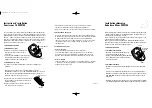
2
Figure 2. Optics Quadrature Signal Generation
Mouse Buttons
Mouse buttons are connected as standard switches.
These switches are pulled up by the pull up resistors
inside the sensor. When the user presses a button, the
switch will be closed and the pin will be pulled LOW to
GND. A LOW state at the pin is interpreted as the button
being pressed. A HIGH state is interpreted as the button
has been released or the button is not being pressed.
Normally the switches are debounced in firmware for 9-
17ms. In this reference design there are three switches:
left, Z-wheel and right.
GND
VDD3
VDD3
VDD5
B3
B2
B1
OPT 1
+3.3V
Vdd 5V
OPT 0
C2
C4
C5
C3
GND
LED_GND
NAV LED
OSC IN
OSC OUT
Vdd 5V
R1
C1
Vdd V5
Mechanical
Z_wheel
3.3V
USB D+
D-
D+
C1, C2, C3 = 0.1uF
C4 = 4.7uF
C5 = 3.3 uF
1.5k
+3.3V
ZA
ZB
or B5
or B4
USB D
−
ADNS-5000
9
7
8
5
6
14
15
18
17
16
12
11
3
4
2
1
10
13
Figure 1. ADNS-5000 3 button Optical Mouse Hardware Block Diagram
Some details on ADNK-5003
The ADNK-5003 reference design mouse unit allows us-
ers to evaluate the performance of the Optical Tracking
Engine (sensor, lens, LED assembly clip, LED) over a USB
protocol. This kit also enables users to understand the
recommended mechanical assembly. (See Appendix C
and D)
System Requirements
PCs using Windows
NT/ Windows
2000 with standard
3-button USB mouse driver loaded.
•
Functionality
•
3-button, scroll wheel mouse.
•
Operating (For USB Mode)
•
Hot pluggable with USB port. The PC does not need
to be powered off when plugging or unplugging the
evaluation mouse.
Downloaded from
Downloaded from


























